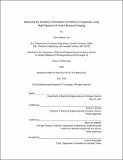| dc.contributor.advisor | Duane S. Boning and Brian W. Anthony. | en_US |
| dc.contributor.author | Lee, John Haeseon | en_US |
| dc.contributor.other | Massachusetts Institute of Technology. Department of Electrical Engineering and Computer Science. | en_US |
| dc.date.accessioned | 2016-12-22T15:16:02Z | |
| dc.date.available | 2016-12-22T15:16:02Z | |
| dc.date.copyright | 2016 | en_US |
| dc.date.issued | 2016 | en_US |
| dc.identifier.uri | http://hdl.handle.net/1721.1/105948 | |
| dc.description | Thesis: Ph. D., Massachusetts Institute of Technology, Department of Electrical Engineering and Computer Science, 2016. | en_US |
| dc.description | This electronic version was submitted by the student author. The certified thesis is available in the Institute Archives and Special Collections. | en_US |
| dc.description | Cataloged from student-submitted PDF version of thesis. Page 119 blank. | en_US |
| dc.description | Includes bibliographical references (pages 115-118). | en_US |
| dc.description.abstract | Concentration measurement of particles in suspension is an important procedure performed in biological and clinical laboratories. Existing methods based on instruments such as hemocytometers, coulter counters, and flow cytometers are often laborious, destructive, and incapable of in vivo measurements. An ultrasound-based method has several unique advantages. It can be nondestructive and noninvasive, which allows a much larger portion of the sample to be analyzed, improving the accuracy and decreasing required sample volume. Also, ultrasound methods have the potential for in vivo measurement in the clinical setting, where cell concentration in liquids such as cerebrospinal fluid can be measured noninvasively without requiring a lumbar puncture. In this work, a new method is presented that estimates absolute particle concentration from high frequency B-mode ultrasound images. The method is based on the detection and characterization of the echoes from individual particles to estimate the effective slice thickness of the image. Prior characterization of the sample is not required because the estimation relies only on parameters that are measured directly from the image. The particle type differential is also performed by using the backscatter coefficient. The method is demonstrated by measuring microsphere suspensions as well as human T cell suspensions using a mechanically scanned single element transducer imaging system and a VisualSonics Vevo 2100. The proposed method has a wide range of potential clinical applications including noninvasive measurement of cell concentration in biological fluids. | en_US |
| dc.description.statementofresponsibility | by John Haeseon Lee. | en_US |
| dc.format.extent | 119 pages | en_US |
| dc.language.iso | eng | en_US |
| dc.publisher | Massachusetts Institute of Technology | en_US |
| dc.rights | M.I.T. theses are protected by copyright. They may be viewed from this source for any purpose, but reproduction or distribution in any format is prohibited without written permission. See provided URL for inquiries about permission. | en_US |
| dc.rights.uri | http://dspace.mit.edu/handle/1721.1/7582 | en_US |
| dc.subject | Electrical Engineering and Computer Science. | en_US |
| dc.title | Measuring the absolute concentration of particles in suspension using high frequency B-mode ultrasound imaging | en_US |
| dc.type | Thesis | en_US |
| dc.description.degree | Ph. D. | en_US |
| dc.contributor.department | Massachusetts Institute of Technology. Department of Electrical Engineering and Computer Science | |
| dc.identifier.oclc | 965235979 | en_US |
